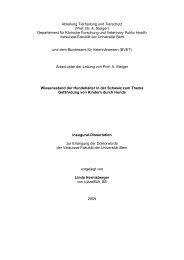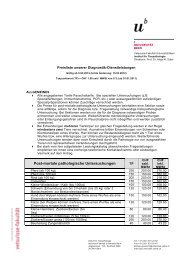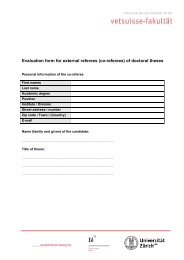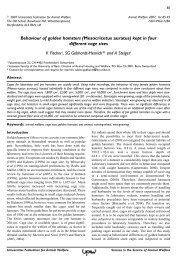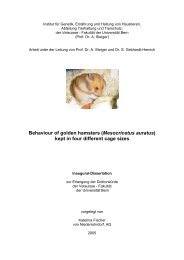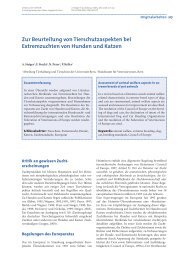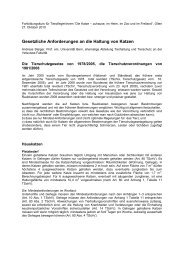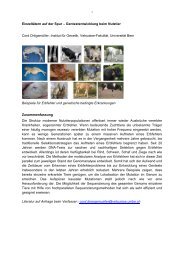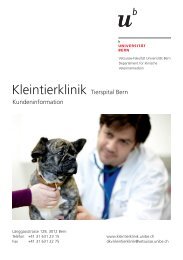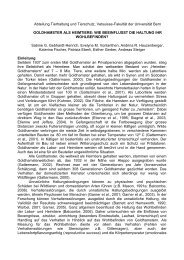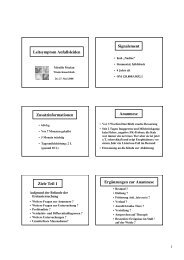Lifespan and Causes of Death in the Irish Wolfhound - Vetsuisse ...
Lifespan and Causes of Death in the Irish Wolfhound - Vetsuisse ...
Lifespan and Causes of Death in the Irish Wolfhound - Vetsuisse ...
Create successful ePaper yourself
Turn your PDF publications into a flip-book with our unique Google optimized e-Paper software.
While <strong>the</strong>re are currently no hereditary diseases <strong>in</strong> <strong>Irish</strong> <strong>Wolfhound</strong>s that can be<br />
diagnosed us<strong>in</strong>g a genetic marker test, two conditions <strong>in</strong> particular do fulfil <strong>the</strong><br />
requirements specified above: DCM <strong>and</strong> PSS.<br />
DCM has a high level <strong>of</strong> prevalence, undoubtedly causes suffer<strong>in</strong>g <strong>and</strong> death <strong>in</strong> <strong>the</strong><br />
dog (<strong>and</strong> considerable veter<strong>in</strong>ary costs for <strong>the</strong> owner), can be easily diagnosed<br />
through <strong>the</strong> published ultrasonography reference values, <strong>and</strong> has a published mode<br />
<strong>of</strong> <strong>in</strong>heritance. The disadvantage is that it cannot be diagnosed from birth, but ra<strong>the</strong>r<br />
manifests <strong>in</strong> dogs that are past <strong>the</strong> age at which <strong>the</strong> first breed<strong>in</strong>g usually takes<br />
place, which implies that ultrasound screen<strong>in</strong>g needs to be repeated throughout <strong>the</strong><br />
breed<strong>in</strong>g career <strong>of</strong> <strong>the</strong> animal <strong>and</strong> also <strong>the</strong>reafter, s<strong>in</strong>ce symptoms <strong>of</strong> hereditary DCM<br />
can still appear at a relatively late age. The approach <strong>of</strong> us<strong>in</strong>g frozen sperm <strong>of</strong> dead<br />
sires known to have been DCM-free throughout <strong>the</strong>ir lives could be a potential means<br />
<strong>of</strong> omitt<strong>in</strong>g this problem (see chapter 7.4.3).<br />
PSS has a high allele frequency <strong>in</strong> <strong>the</strong> population, causes an important degree <strong>of</strong><br />
suffer<strong>in</strong>g <strong>and</strong>, potentially, death <strong>in</strong> affected animals (<strong>and</strong> also considerable costs for<br />
treatment), can be diagnosed at an early age through rout<strong>in</strong>e screen<strong>in</strong>g, <strong>and</strong> has a<br />
published mode <strong>of</strong> <strong>in</strong>heritance that makes <strong>in</strong>direct identification <strong>of</strong> carriers possible<br />
through <strong>the</strong> screen<strong>in</strong>g <strong>of</strong> <strong>the</strong>ir direct progeny.<br />
Where o<strong>the</strong>r diseases follow a def<strong>in</strong>ed mode <strong>of</strong> <strong>in</strong>heritance (PCD, vWD, PRA,<br />
Epilepsy), control measures based on <strong>the</strong> po<strong>in</strong>ts mentioned <strong>in</strong> chapter three suggest<br />
<strong>the</strong>mselves. As for <strong>the</strong> major diseases with hereditary components (OS, GDV <strong>and</strong>,<br />
depend<strong>in</strong>g on <strong>the</strong> actual prevalence, OC), <strong>the</strong> establish<strong>in</strong>g <strong>of</strong> multi-parametric<br />
selection based on BLUP-estimated breed<strong>in</strong>g values derived from a central health<br />
registry would be <strong>the</strong> means <strong>of</strong> choice (also see chapter 7.4.4).<br />
However, it is also important to stress that <strong>the</strong> prevalence levels <strong>of</strong> hereditary<br />
diseases may vary between different populations, which may lead to differences <strong>in</strong><br />
<strong>the</strong> most appropriate selection strategy for a given population (also see chapter<br />
6.2.7). Given <strong>the</strong> amount <strong>of</strong> genetic afflictions <strong>in</strong> <strong>the</strong> breed, it is impossible to<br />
recommend a general strategy that will be applicable to all populations. Never<strong>the</strong>less,<br />
<strong>the</strong> <strong>in</strong>formation concern<strong>in</strong>g modes <strong>of</strong> <strong>in</strong>heritance <strong>and</strong> control measures mentioned <strong>in</strong><br />
chapter 3 will hopefully give a solid base on which to develop breed<strong>in</strong>g programs that<br />
are adapted to different populations' specific needs. Work<strong>in</strong>g to make solid health<br />
data on which to base such strategies available is <strong>of</strong> paramount importance <strong>in</strong> this<br />
context (also see chapter 7.4.4 below).<br />
7.4.3 <strong>Lifespan</strong><br />
It has been shown that <strong>the</strong>re are genetic contributions to can<strong>in</strong>e lifespan per se<br />
(Canterberry, Greer et al. 2005), but <strong>the</strong>ir <strong>in</strong>fluence <strong>in</strong>dependent from hereditary<br />
disease predispositions rema<strong>in</strong>s unclear. The differences found between direct<br />
progeny <strong>of</strong> popular sires <strong>in</strong> this study (see chapter 6.2.5) are an <strong>in</strong>dication towards<br />
such an effect, but <strong>in</strong>sufficient as pro<strong>of</strong>. Heredity <strong>of</strong> work<strong>in</strong>g lifespan has been<br />
<strong>in</strong>vestigated <strong>in</strong> German Shepherds <strong>and</strong> Labrador Retrievers used as guide dogs<br />
(Cole 2003), but <strong>the</strong> heritability values found were low (h 2 = 0.016 to 0.032). S<strong>in</strong>ce<br />
work<strong>in</strong>g lifespan <strong>and</strong> effective lifespan are not necessarily identical, <strong>the</strong> significance<br />
<strong>of</strong> <strong>the</strong>se f<strong>in</strong>d<strong>in</strong>gs to <strong>Irish</strong> <strong>Wolfhound</strong>s rema<strong>in</strong>s unclear.<br />
111



